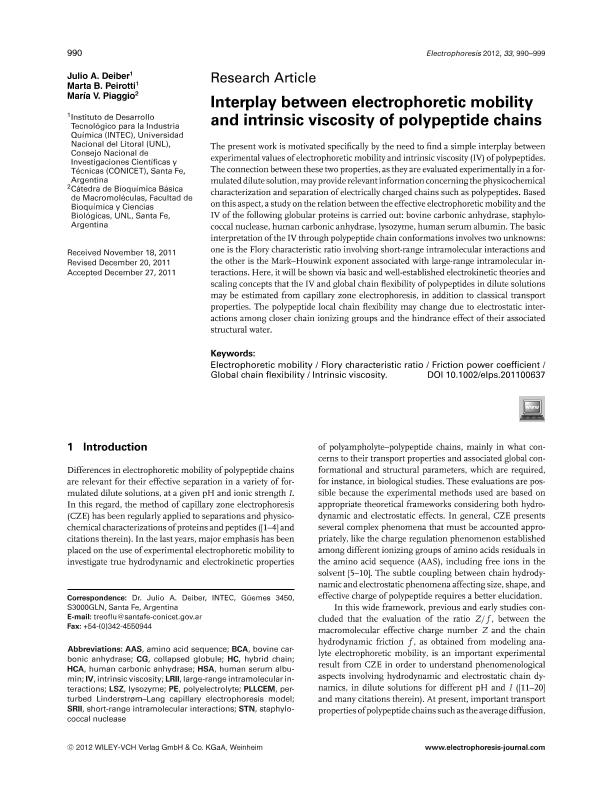Mostrar el registro sencillo del ítem
dc.contributor.author
Deiber, Julio Alcides

dc.contributor.author
Peirotti, Marta Beatriz

dc.contributor.author
Piaggio, María Virginia

dc.date.available
2017-06-23T19:08:00Z
dc.date.issued
2012-04
dc.identifier.citation
Deiber, Julio Alcides; Peirotti, Marta Beatriz; Piaggio, María Virginia; Interplay Between Electrophoretic Mobility and Intrinsic Viscosity of Polypeptide Chains; Wiley Vch Verlag; Electrophoresis; 33; 6; 4-2012; 990-999
dc.identifier.issn
0173-0835
dc.identifier.uri
http://hdl.handle.net/11336/18770
dc.description.abstract
The present work is motivated specifically by the need to find a simple interplay between experimental values of electrophoreticmobility and intrinsic viscosity (IV) of polypeptides. The connection between these two properties, as they are evaluated experimentally in a formulated dilute solution,may provide relevant information concerning the physicochemical characterization and separation of electrically charged chains such as polypeptides. Based on this aspect, a study on the relation between the effective electrophoretic mobility and the IV of the following globular proteins is carried out: bovine carbonic anhydrase, staphylococcal nuclease, human carbonic anhydrase, lysozyme, human serum albumin. The basic interpretation of the IV through polypeptide chain conformations involves two unknowns: one is the Flory characteristic ratio involving short-range intramolecular interactions and the other is the Mark–Houwink exponent associated with large-range intramolecular interactions. Here, it will be shown via basic and well-established electrokinetic theories and scaling concepts that the IV and global chain flexibility of polypeptides in dilute solutions may be estimated from capillary zone electrophoresis, in addition to classical transport properties. The polypeptide local chain flexibility may change due to electrostatic interactions among closer chain ionizing groups and the hindrance effect of their associated structural water.
dc.format
application/pdf
dc.language.iso
eng
dc.publisher
Wiley Vch Verlag

dc.rights
info:eu-repo/semantics/openAccess
dc.rights.uri
https://creativecommons.org/licenses/by-nc-sa/2.5/ar/
dc.subject
Electrophoretic Mobility
dc.subject
Friction Power Coefficient
dc.subject
Flory Characteristic Ratio
dc.subject
Global Chain Flexibility
dc.subject
Intrinsic Viscosity
dc.subject.classification
Otras Ingeniería de los Materiales

dc.subject.classification
Ingeniería de los Materiales

dc.subject.classification
INGENIERÍAS Y TECNOLOGÍAS

dc.title
Interplay Between Electrophoretic Mobility and Intrinsic Viscosity of Polypeptide Chains
dc.type
info:eu-repo/semantics/article
dc.type
info:ar-repo/semantics/artículo
dc.type
info:eu-repo/semantics/publishedVersion
dc.date.updated
2017-06-21T18:39:57Z
dc.journal.volume
33
dc.journal.number
6
dc.journal.pagination
990-999
dc.journal.pais
Alemania

dc.journal.ciudad
Berlín
dc.description.fil
Fil: Deiber, Julio Alcides. Consejo Nacional de Investigaciones Científicas y Técnicas. Centro Científico Tecnológico Conicet - Santa Fe. Instituto de Desarrollo Tecnológico para la Industria Química. Universidad Nacional del Litoral. Instituto de Desarrollo Tecnológico para la Industria Química; Argentina
dc.description.fil
Fil: Peirotti, Marta Beatriz. Consejo Nacional de Investigaciones Científicas y Técnicas. Centro Científico Tecnológico Conicet - Santa Fe. Instituto de Desarrollo Tecnológico para la Industria Química. Universidad Nacional del Litoral. Instituto de Desarrollo Tecnológico para la Industria Química; Argentina
dc.description.fil
Fil: Piaggio, María Virginia. Universidad Nacional del Litoral; Argentina
dc.journal.title
Electrophoresis

dc.relation.alternativeid
info:eu-repo/semantics/altIdentifier/doi/http://dx.doi.org/10.1002/elps.201100637
dc.relation.alternativeid
info:eu-repo/semantics/altIdentifier/url/http://onlinelibrary.wiley.com/doi/10.1002/elps.201100637/abstract
Archivos asociados
